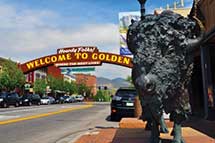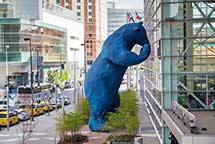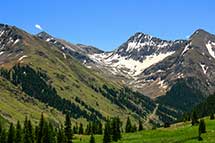 Golden, Colorado came into existence because of, well, um... GOLD! During the middle of the 19th century, gold was discovered in Clear Creek, which runs through the heart of downtown Golden today. Golden City (actually named for Thomas L. Golden, a miner from Georgia who was an early prospector in the area around Golden) was founded in 1859. The town grew rapidly as a source of supply for mining activities in the nearby mountains and as the home of several smelters engaged in extracting gold, silver, and other metals from ores from the mines. From 1862 until 1867, Golden City served as the capital of the Territory of Colorado (in 1867, Denver City became the territorial capital and then, as Denver, became the capital of the State of Colorado in 1876). Golden today is the county seat of Jefferson County.
Golden, Colorado came into existence because of, well, um... GOLD! During the middle of the 19th century, gold was discovered in Clear Creek, which runs through the heart of downtown Golden today. Golden City (actually named for Thomas L. Golden, a miner from Georgia who was an early prospector in the area around Golden) was founded in 1859. The town grew rapidly as a source of supply for mining activities in the nearby mountains and as the home of several smelters engaged in extracting gold, silver, and other metals from ores from the mines. From 1862 until 1867, Golden City served as the capital of the Territory of Colorado (in 1867, Denver City became the territorial capital and then, as Denver, became the capital of the State of Colorado in 1876). Golden today is the county seat of Jefferson County.
In 1873, two German immigrants, Adolph Coors and Jacob Schueler, started a brewery in Golden. In 1880, Coors bought out Schueler and went on to establish the largest single-site brewery in the world. In 1874, the School of Mines, originally operated by the Episcopal Church in Golden, was acquired by the Territory and ultimately became Colorado School of Mines, a state institution, when Colorado gained statehood in 1876. One of the original buildings, Engineering Hall, built in 1894 remains in use on the campus.
Today, Golden is a city with a population of about 20,000. It still retains its small western town character, but is part of the larger Denver metropolitan area — with access to the many cultural and social benefits the metropolis has to offer. Serving as the gateway to the Rocky Mountains, Golden also has many hiking trails, ranging from easy hikes along historic Clear Creek to challenging treks into the foothills. Golden is the home of the American Mountaineering Center and the Colorado Mountain Club, and boasts a world-class kayack course and parasailing from the top of Mount Zion — and all of these opportunities are within walking distance of the Colorado School of Mines campus.
With easy access to I-70 and other highways into the mountains, Golden is only a short drive away from many resorts and outdoor activities — mountain climbing, hiking, biking, kayaking, canoeing, and a host of others.
More information about Golden can be found by visiting some of the following websites:
http://www.cityofgolden.net/play/recreation-attractions/
http://www.cityofgolden.net/play/recreation-attractions/trails/
http://www.cityofgolden.net/play/recreation-attractions/clear-creek-white-water-park/
http://www.buffalobill.org/
http://visitgolden.com/
http://www.goldencochamber.org/
Golden Weather and Terrain
Golden is situated at the foot of the Rocky Mountains. The elevation (altitude) of the Colorado School of Mines campus is approximately 5,800 feet (1,768 meters) above sea level.
Weather in Golden is generally seasonal, with cold temperatures in winter (December through February), hot temperatures in summer (June through August), and variable temperatures in spring and fall. However, due to the proximity of the Rocky Mountains and the city's altitude, temperatures can vary widely from the norm on a day-to-day basis.
Precipitation in the area is generally infrequent, with average annual equivalent rainfall of 15 inches (38 centimeters). Precipitation generally occurs as snow in winter, late fall, and early spring, and as rain during the remainder of the year. Snowfall in the winter can be significant, with accumulations greater than 6 inches (15 centimeters) being common. Summer days can experience severe thunderstorms in the afternoon.
Current weather information and near-term forecasts for Golden are available on the Internet. Learn more...
Visitors unaccustomed to the combination of Golden's altitude and generally dry climate are encouraged to drink plenty of fluids to avoid dehydration and to be cautious if engaging in rigorous exercise.
 Contrary to a popularly held misconception, Denver is not located in the Rocky Mountains. The center of the city is at least 15 miles away from the big peaks and deep valleys and is actually located on the broad plains that slope gently all the way to the middle of the United States. But with the Rockies just a hop, skip, and jump away, heading for the mountains is easily accomplished.
Contrary to a popularly held misconception, Denver is not located in the Rocky Mountains. The center of the city is at least 15 miles away from the big peaks and deep valleys and is actually located on the broad plains that slope gently all the way to the middle of the United States. But with the Rockies just a hop, skip, and jump away, heading for the mountains is easily accomplished.
Denver was formally established in the middle of the 19th century, and the railroads came to town in the 1870s. Although the first transcontinental railroad bypassed Denver by going through Wyoming, businessmen in Denver quickly built their own railroad to connect the city with the transcontinental route at Cheyenne, Wyoming. This connection allowed Denver to grow and prosper as part of the settlement of the western United States. When gold and silver were discovered in the Colorado mountains, more railroads were built from Denver south and west to get the miners in and the precious metals out. Denver continued to grow into one of the largest cities between the Mississipi and the west coast.
Today Denver is the capital of Colorado and is home to the State Capitol, which houses the state Senate and House of Representatives along with the Office of the Governor. The dome of the capitol is covered in real 24K gold, and the elevation (5,280 feet above sea level) of one of the steps of the building gives Denver its nickname of The Mile High City. Being a mile high and also being located out on the high plains makes for a relatively dry climate, with only about 15 inches of equivalent rainfall per year. Denver boasts of having an average of 300 days of sunshine per year.
Denver is both a city and a county and has a population of more than 630,000. Denver is part of a greater metropolitan area consisting of nearly 30 cities and municipalities — with a combined population of over 2.7 million people. The Denver area continues to grow at a fast pace.
Denver supports a number of professional sports organizations, including the Denver Broncos (football), the Colorado Rockies (baseball), the Denver Nuggets (basketball), the Colorado Avalanche (ice hockey), and the Colorado Rapids (soccer). Denver also has the distinction of brewing more beer than any other city in the nation, with over 200 different beers brewed daily. And for those whose passion is golf, it's good to know that a golf ball flies about 10% farther in Denver than at sea level because of the thinner atmosphere at Denver's elevation.
More information about Denver can be found by visiting some of the following websites:
http://www.denver.org
http://www.movoto.com/guide/denver-co/denver-facts
http://www.colorado.com/cities-and-towns/denver
http://www.denver.com
 Colorado became the 38th state of the United States in 1876. Since it was admitted to the Union 100 years after the signing of the Declaration of Independence, Colorado claimed the nickname The Centennial State. Colorado is the 8th largest state, with an area of over 104,000 square miles, and is the 22nd most populous, with a population of more than 5.3 million people.
Colorado became the 38th state of the United States in 1876. Since it was admitted to the Union 100 years after the signing of the Declaration of Independence, Colorado claimed the nickname The Centennial State. Colorado is the 8th largest state, with an area of over 104,000 square miles, and is the 22nd most populous, with a population of more than 5.3 million people.
The common perception that Colorado is all mountains and valleys is not correct; in fact, nearly half of Colorado consists of relatively flat terrain that is part of the high plains of the United States. This eastern "half" of the state supports agriculture and ranching of all sorts, including wheat, corn, soybeans, and livestock.
The western "half" of the state is the most well-known, since much of that area is part of the Rocky Mountains. Extending from the lower mountains immediately to the west of Denver and other front range cities to the towering peaks like Pikes Peak (14,115 feet elevation) and Mount Elbert (14,440 feet; highest point in the Rocky Mountains), the mountainous area of Colorado supports mining, tourism, and, of course, skiiing. Colorado is home to more than 20 mountain ski resorts.
Recreation possibilities in Colorado range from hobnobbing with the glitterati in Aspen to backpacking in Rocky Mountain National Park to exploring the vast vistas of the Pawnee National Grasslands. Colorado is home to three National Forests, four National Parks, eight National Monuments, three National Historic Areas, forty-two State Parks, more than three hundred State Wildlife Areas, and countless county and city Open Space Areas. Mountain resorts include Aspen, Glenwood Springs, Telluride, Steamboat Springs, Breckenridge, Vail, and more. And while skiing, snow boarding, and snow mobiling are the prime winter activities in those resorts, spring, summer, and fall offer hiking, biking, bungee jumping, and zip lines. Fun goes on year-round, non-stop.
For more sedate entertainment, the close-to-Denver towns of Black Hawk and Central City offer Las Vegas-style casinos in a beautiful mountain setting — about an hour away from Denver by bus. Visit the Hotel de Paris in Georgetown, take a drive on the highest paved road in North America on Mount Evans, tour a gold mill in Idaho Springs, or attend the opera in Central City.
In Colorado, visitors can ride on ten tourist railroads, pan for gold, raft down a river, ski down a mountain, climb up a mountain (53 peaks higher than 14,000 feet), try their luck in a casino, camp out under the stars, and much, much more. More information about Colorado can be found by visiting some of the following websites:
http://www.colorado.com/
http://www.mtn-resorts.com/
http://www.coloradoscenicrails.com/
http://www.blackhawkcolorado.com/
http://www.centralcitycolorado.com/

